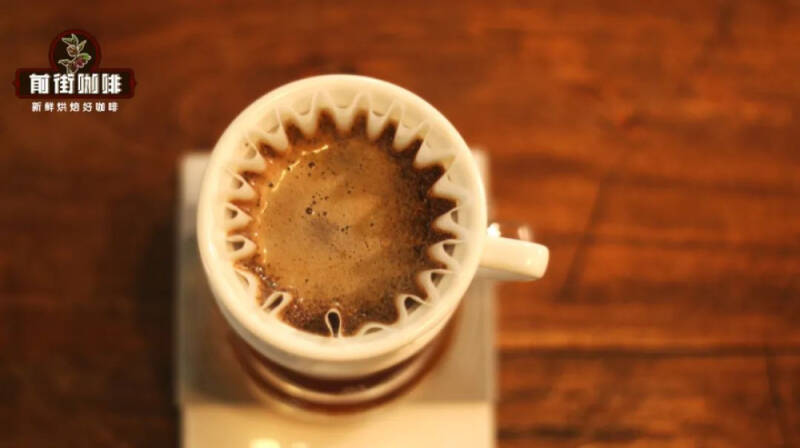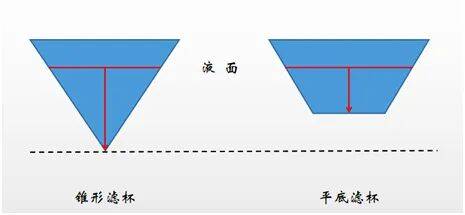Why does the flat-bottomed filter cup have a lower rollover rate? What are the characteristics of the cake filter cup? What kind of cooking method is suitable?
In the coffee filter circle, we always hear such a saying: coffee with a flat filter cup is not easy to overturn, so it is the friendliest for beginners. In many articles, the front street occasionally mentions that the flat filter cup has the advantage of making coffee more evenly extracted, so how does it work?

The biggest difference between a flat filter cup and a conical filter cup is that the coffee powder poured can form different forms. If we look at it from the side, the conical filter cup has an inverted triangle in powder layer section, while the flat-bottomed filter cup has a trapezoid with a wide top and a narrow bottom.

Conical filter cups, for example, Hario V60 and KONO, which are produced daily in the street, the thicker the powder layer toward the center, the greater the penetration resistance of coffee to water, and the higher the extraction rate formed; the closer to the filter cup wall, the thinner the powder layer, and the easier it is for coffee to release soluble substances. Therefore, in terms of technique, when using a conical filter cup to brew coffee, we have more room for adjustment to present the layering of coffee. Correspondingly, however, if you want to extract all the coffee powder as evenly as possible, you will have higher requirements for the water control ability of the brewer.
Back to today's theme flat filter cup, take the cake filter cup with the highest appearance rate as an example. The round flat bottom makes the coffee powder fall into a thinner shape, and the thickness is basically similar, and the penetration resistance to hot water is weaker. The bottom is usually 3 to 4 small holes connected by staggered convex lines to support the filter paper at the bottom, in order to help maintain a comfortable launching speed.
We should know that almost all filter cups extracted under atmospheric pressure are used simultaneously with drip extraction and immersion extraction. Because the cake cup only relies on a few small holes at the bottom of the water, the filtration speed is slower, which makes the proportion of its immersion extraction significantly increased, so the coffee that is washed out pays more attention to the flavor substances in the middle and later stages, and the performance in roundness and mellow is relatively better.
When filtered through a cake cup, hot water hits the center point and spreads radially around before escaping through the hole at the bottom. In this way, even if the water flow is not evenly injected, the water level in the filter cup can still be kept horizontal throughout the whole process, so that most particles can "eat" water evenly, and have a higher fault tolerance rate than the conical filter cup, and the consistency of the product is better. But it also means that the less efficient it is, the less room it can adjust.
Stability is the first consideration of countless stores, so many world-famous stores will also give priority to cake filter cups when producing hand-brewed black coffee. This is also the main reason why people often say that coffee is brewed with a flat filter cup, and the rollover rate is lower.
The rib design of this flat-bottomed filter cup is generally divided into two types, one is the horizontal distribution of circular ribs, used to lock water; the other is like the vertical ribs of V60, which mainly plays the role of drainage.
For example, Wave series cake cups have a circle of individual ring dents on the inside. In addition to slowing down the speed of water flow, the ring also allows water from high places to move along the dents to another lower position, thus keeping the water level as level as possible during brewing.
For example, Lili filter cup designed and improved from Melitta101 in Germany, although it is also a flat-bottom filter cup, but the inside of the cup body has been changed to 48 top-down guide ribs to improve the flow rate, and the bottom is 8 circular water holes, the purpose is to make coffee powder extraction difficult to block and deposit.
However, since the cake filter cup is often used with this kind of flat-bottom filter cup, only the outward crease can be attached to the cup body, thus playing the water-locking/hydrophobic effect, so compared with the conical filter cup with higher filter paper attachment, the rib diversion effect of the flat-bottom filter cup will be relatively weak.
Of course, in addition to the above classic styles with small apertures, in recent years, in order to cater to the extraction trend of "fine powder fast rush," many flat-bottom filter cups emphasizing "high water speed" have been born on the market. For example, the ice pupil B75 introduced by Qianjie, the Torch doughnut filter cup in Japan, the April Brewer designed by Danish baristas, etc., all work hard on the bottom structure to make the ground coffee powder finer to achieve a more three-dimensional immersion extraction + drip extraction dual effect.
- END -
Front Street Cafe
No.10 Baoanqian Street, Yandun Road, Dongshankou, Yuexiu District, Guangzhou City, Guangdong Province
Important Notice :
前街咖啡 FrontStreet Coffee has moved to new addredd:
FrontStreet Coffee Address: 315,Donghua East Road,GuangZhou
Tel:020 38364473
- Prev

Lucky coffee machine malfunctioned? Netizen: this belongs to squirrel!
▲ Click to follow | Daily boutique Coffee Culture Magazine Coffee Workshop in the upsurge of coffee culture, Luckin Coffee has won the love of many Raymen people for its efficiency and convenience as well as its own affordable price. However, even the most efficient fully automatic coffee machines will inevitably appear in lucky stores, which are often full of orders.
- Next

Where does the smell of iced coffee come from? What are the grindness, proportion and parameters for making cold-extracted coffee? What is low temperature ripening?
"clean, mellow and smooth" is people's second impression of the ice drop after tasting it. Why is it the second? Because often, people will be shocked by its strong and long-lasting fermented wine aroma, and only when they come to their senses do they begin to notice that it tastes so excellent. Like some friends who have just come into contact with ice droplets in the front street store.
Related
- What effect does Italian American coffee with filter paper have? Will coffee taste better if it is put on filter paper at the bottom of the powder bowl?
- What is the color difference in coffee beans? What are the characteristics of honey processed coffee beans? Why are the anaerobically treated coffee beans uneven in color?
- How does novice Xiaobai quickly get started and make coffee? Newbies learn to make coffee by hand and share the specific steps and process process!
- Costa tea has a shelf life of 100 years?! Expert: Unable to verify
- It's a huge uproar! American milk addition was rejected by Manner employees?!
- Mocha pot coffee bean recommendations| How fine and how much powder should be used for grinding? What parameter ratios do I need to use to make milk with Mocha pot coffee?
- What are the characteristics of the world's top ten coffee beans treated with Costa Rica honey? How to make black honey kadura from Tarazhu Pilon Processing Plant taste good?
- How to make deep-roasted coffee? What grinding water temperature does authentic Jamaica Blue Mountain No. 1 coffee use to brew it well?
- Selected high-grade rose summer coffee flavor tasting guide Why Panama rose summer has the aroma of flowers and fruits
- What equipment does a novice Xiaobai need to buy to learn to make coffee? Filter cup electronic scale bean grinder manual flushing pot purchase guide

